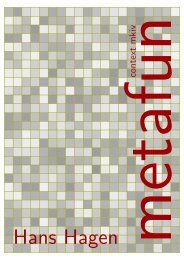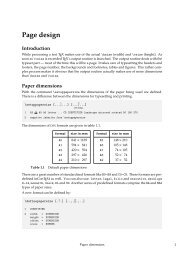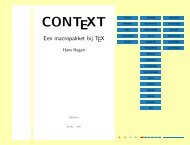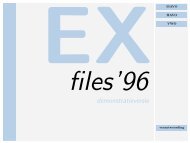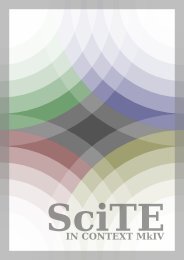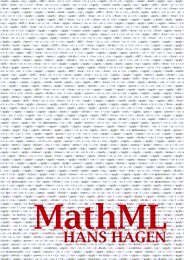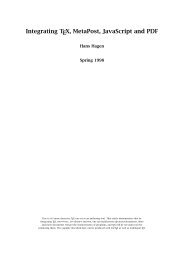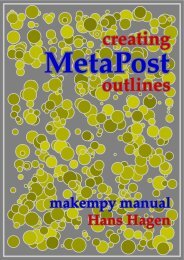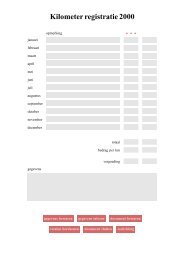Hagen - Pragma ADE
Hagen - Pragma ADE
Hagen - Pragma ADE
You also want an ePaper? Increase the reach of your titles
YUMPU automatically turns print PDFs into web optimized ePapers that Google loves.
[complete]<br />
[always]<br />
[compose=yes,<br />
liga=yes,<br />
tlig=yes,<br />
trep=yes]<br />
\definefontfeature<br />
[none]<br />
[mode=none,<br />
features=no]<br />
These definitions show that you can construct feature sets on top of existing ones, but<br />
keep in mind that they are defined instantly, so any change in the parent is not reflected<br />
in its kids.<br />
In a font definition you can specify more than one set:<br />
\definefont<br />
[MyFont]<br />
[Bold*always,oldstyle at 12.3pt]<br />
4.4 @ (virtual features)<br />
This method is somewhat special as it demands knowledge of the internals of the ConT E Xt<br />
font code. Much of it is still experimental but it is a nice playground. A good example of<br />
its usage can be found in the file m-punk.mkiv where we create a font out of METAPOST<br />
graphics.<br />
Another example is virtual math. As in the beginning of LuaT E X and MkIV there were<br />
only a few OpenType math fonts, and as I wanted to get rid of the old mechanisms, it<br />
was decided to virtualize the math fonts. For instance a Latin Modern Roman 10 point<br />
math font can be defined as follows:<br />
\definefontsynonym<br />
[LMMathRoman10-Regular]<br />
[LMMath10-Regular@lmroman10-math]<br />
The lmroman10-math refers to a virtual definition and in this case it is one using a builtin<br />
constructor and therefore we use a goodies file to specify the font. That file looks as<br />
follows:<br />
return {<br />
name = "lm-math",<br />
version = "1.00",<br />
comment = "Goodies that complement latin modern math.",<br />
author = "Hans <strong>Hagen</strong>",<br />
53<br />
Methods



